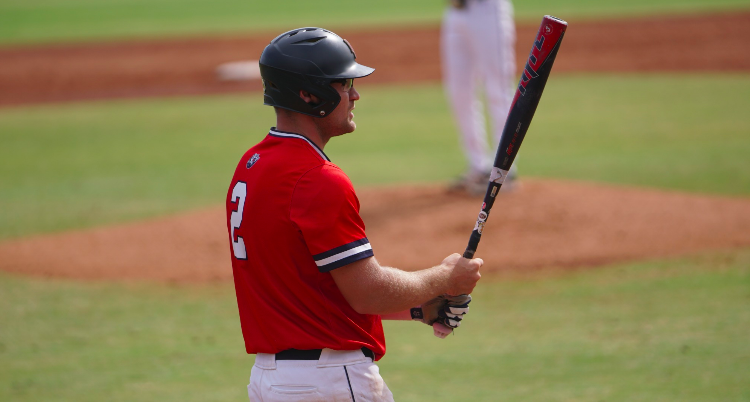
BY STEVE KRAH
http://www.IndianaRBI.com
Moneyball — the film based on the non-fiction book “Moneyball: The Art of Winning an Unfair Game” by Michael Lewis — came out in 2011.
Brodey Heaton was 9 or 10 and living in Newburgh, Ind., when he first saw it.
“I liked the storyline and as I grew up and started getting more into math and statistics it just started becoming my favorite movie,” says Heaton, who is a first baseman — the same position played by Scott Hatteberg of the Oakland Athletics in real life and the film.
Now 22 and a 6-foot-5, 235-pounder at NCAA Division I Belmont University in Nashville, Tenn., Heaton has already earned an undergraduate degree in Applied Mathematics.
With an extra year of eligibility because of the COVID-19 pandemic, Heaton plans to play for the Bruins again in 2024 while pursuing a Master of Sport Administration.
Batting primarily in the 3-hole, Heaton has played in 52 games (50 starts) in 2023 and is hitting .241 (46-of-191) with six home runs, 10 doubles, 33 runs batted in, 28 runs scored and .724 OPS (.326 on-base percentage plus .398 slugging average).
“I try to drive in runs or be productive for the team — try to have a tough at-bat and set up the rest of the lineup the best I can,” says Heaton, who went 2-of-3 and scored a run Tuesday, May 16 at Tennessee.
For his college career, the righty swinger/thrower has played in 174 games (172 starts) and is hitting .286 (191-of-669) with 23 homers, 39 doubles, 149 RBIs, 97 runs and .825 OPS (.360/.465).
Heaton was an all-Ohio Valley Conference tournament team in 2022. If Belmont (23-30, 8-16) qualifies for the 2023 Missouri Valley Conference tourney, that event is May 23-27 at Indiana State.
Teammates voted Heaton and left-handed pitcher Andy Bean as co-captains for 2023.
“Part of my job is the communicate between the coaches and the rest of the team,” says Heaton. “And to be an extra coach out there. Since I’ve probably been here the longest I help the new guys out and give them little pointers when they need it.
“It’s also being a relaxing presence for people and showing them the way we do things at Belmont.”
In that way, Heaton is a reflection of his veteran head coach.
Dave Jarvis is in his 26th season as Belmont head coach and 41st year of coaching overall.
“He’s a calm presence in the dugout,” says Heaton of Jarvis. “He’s always positive. He’s always telling us to be calm and ready for the moment.”
Heaton benefits from physical strength and mental acuity, honed by playing football (tight end), basketball (power forward) and baseball (first base) at Castle High School, where he graduated in 2019.
“Strength is a big part of my game now,” says Heaton. “I’ve always been naturally strong but in my years at Belmont I’ve put in a lot more work in the weight room. I’ve gotten a lot more strength, especially in my lower body. I’ve worked with our strength coach (assistant sports performance coach Jarett Thompson) just to stay healthy and strong.
“It’s paid dividends for me.
“I’m not the quickest. Playing three sports in high school has made me more athletic. My Baseball I.Q. helps me know what’s going on and get to balls or take extra bases.”
Curt Welch was Heaton’s head baseball coach in high school, instilling drive and providing life lessons.
“He is super competitive,” says Heaton of Welch. “He wants it a lot out there and he takes that into his teams.
“He has that attention to detail. You can just tell that he wants to make us competitive. I really appreciated playing for him.”
As a senior, Heaton hit .392 and was named to the Indiana High School Baseball Coaches Association North/South All-Star Series in Madison and was all-state honorable mention, first-team all-Southern Indiana Athletic Conference and the All-Metro Player of the Year. He helped the Knights win two sectionals and two regionals.
Growing up in Newburgh, Heaton started out with local teams, played Newburgh Junior Baseball in middle school and was with the Indiana Bulls travel organization from 11U to 17U. Sean Laird was the head coach in his 17U summer. He then went with the Jeremy Johnson-coached Evansville Razorbacks before heading to Belmont.
After his freshman season with the Bruins, Heaton went to College Summer League at Grand Park in Westfield, Ind.
Early in the 2021 spring season, he suffered a torn labrum in his left hip and partially-torn quadriceps and played through it. Surgery kept him off the field that summer.
Heaton played for the New England Collegiate Baseball League’s Ocean State Waves in 2022 and expects to go back to South Kingstown, R.I., this summer.
Bryan and Crystal Heaton have two children — Brodey and Katelyn (19). Bryan Heaton is a project manager for Toyota. Crystal Heaton is in the finance department of Deaconess Health System. Katelyn Heaton is studying speech therapy at Murray (Ky.) State University.








